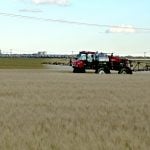The day started with an overnight shower followed by a warm May sun. Cows and horses everywhere enjoyed new growth on year-old pastures. A panic call from a good dairy client at Balgonie interrupted supper.
Mike, almost inarticulate, pleaded, “Doc, come right away. Two cows have died; another 15 are seriously bloated. I turned the herd onto a patch of alfalfa after milking. Forgot about the rain and new growth. What can I do?”
“I’ll stop by the clinic for medicine and be right out. Get the cows in the barn.”
Read Also

The Canadian Cattle Association’s international advocacy efforts
Global ag policies affect Canadian food policy, so the Canadian Cattle Association participates in international and domestic forums
Knowing how quickly things can deteriorate, I left Judith’s meatloaf, my favourite, and took off. I grabbed 36 bottles of Bloat-Eze, a peppermint-flavoured, bright-green compound containing dioctyl used for treating frothy bloat, and headed east on Highway 1 well over posted speed limits. Just beyond White City, a highway patrol officer stopped me. I ran back to his cruiser and tried to explain the emergency that was unfolding six miles away.
The young corporal acknowledged the urgency as he put my driver’s license in a front pocket of his freshly pressed tunic. “Please proceed. I’ll follow, but drive the speed limit.”
Mike wondered what happened when I drove into his yard with a police cruiser on my tail. I simply said, “I’ll explain later. Let’s deal with the cows.”
- Veterinary Case Study: The essentials to achieving anything worthwhile
The young corporal originated from downtown Montreal. Regina (Division F) turned out to be his first posting following graduation from RCMP Depot. The milk cooler in grocery stores was the closest experience he’d had to a dairy farm. I represented the first farm veterinarian he had ever met and bloat in cattle constituted an entirely new adventure for a city kid.
Mike and I peeled the tops off a dozen Bloat-Eze bottles and emptied them into a stainless-steel pail. We started down the row of bloated animals — me passing the stomach tube through a speculum in each cow and Mike pumping eight to 10 ounces of Bloat-Eze into individual animals as we moved from stanchion to stanchion. We were making great headway until Mike started to tire. The young policeman could see Mike needed to be relieved and asked if he could man the stomach pump.
“Of course,” Mike replied and stepped aside.
On the second cow, after the young Mountie took over, the rubber stomach tube detached from the stomach pump and Bloat-Eze exploded from the friction-fit junction between the stomach pump and stomach tube, aided in part by the high-pressure down-stroke of a stomach pump in the hands of a muscular young man and the backpressure of a bloated rumen. Bloat-Eze covered everything and everybody.
“This will take some explaining to my coffee-shop buddies,” was all the young corporal could say.
Bloat-Eze worked as advertised. Bloated cows recovered quickly after treatment. No more died. As we finished re-treating a few that remained bloated, the young policeman reached in his pocket and slid my driver’s license into the front pocket of my coveralls.
“Thanks for the demonstration,” he said.
He vomited in the gutter as he left the barn, the smell of rumen gases more than he had learned to tolerate on the streets of Montreal.
Dr. Ron Clarke is a veterinarian who consults on animal health and disease issues and writes for agricultural and veterinary audiences.

















